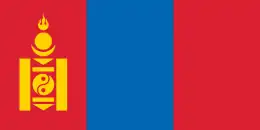Mongolian diaspora
The Mongolian diaspora refers to people of the modern country of Mongolia who live outside Mongolia. According to the Mongolian census of 2020, 122,301 Mongolian nationals were reported to be living abroad for more than six months, an increase of 14% from the last census in 2010.[3] The largest Mongolian populations were recorded as being in South Korea, the United States, Japan, Kazakhstan, and the Czech Republic.[1] 3.7% of the total population resides abroad.
 | |
| Total population | |
|---|---|
| 122,301 (2020 Census)[1] | |
| 39,982 (2020) | |
| 19,170 (2020) | |
| 17,976 (2023) | |
| 11,000 (2023)[2] | |
| 7,218 (2020) | |
| 5,997 (2020) | |
| 5,146 (2020) | |
| 3,972 (2020) | |
| 3,951 (2020) | |
| Languages | |
| Mongolian | |
| Related ethnic groups | |
| Mongols | |
Demographics
According to the 2020 census, the diaspora was reported to mostly be of working age, skewing female, with the population of children (0-14) almost doubling from 2010 to 2020, indicating more long-term settlement abroad. 74.5% of the diaspora population originated from Ulaanbaatar, with the next most common provinces of origin being Bayan-Ölgii, Darkhan-Uul, and Orkhon.[1]
Mongolians residing in Europe were reported to have the highest average duration of settlement (11+ years), while those in Russia, China, South Korea, and Japan were mostly short-term residents (less than 1 year).[1]
In the European Union, the Czech Republic has the largest Mongolian diaspora, out of which the vast majority reside in the North Bohemian city of Česká Lípa. The community there grew so significantly in the last five years that out of the approximately 400 “foreign” students in the local elementary schools, 300 of them are of Mongolian descent. The city had to take special measures by employing native Mongolian speakers in the local schools to be able to educate the local Mongolian diaspora youth.
The majority (46.7%) of Mongolians abroad initially went as students, and 44% of the diaspora population had tertiary degrees.[1]
References
- "Migration2020.pdf". National Statistical Office of Mongolia. 2021. Retrieved 27 Aug 2023.
- iKon.mn, Г. Мөрөн (2023-04-03). ""Австралид бага насны хүүхдийг олон нийтийн газар нүцгэн авч явах, бусдын биед хүрэх нь зөрчилд тооцогдоно"". ikon.mn. Retrieved 2023-04-03.
- "Шилжилт хөдөлгөөн буурсан ч гадаадад суурьшсан иргэдийн тоо өсөв". sonin.mn (in Mongolian). Retrieved 2023-08-26.